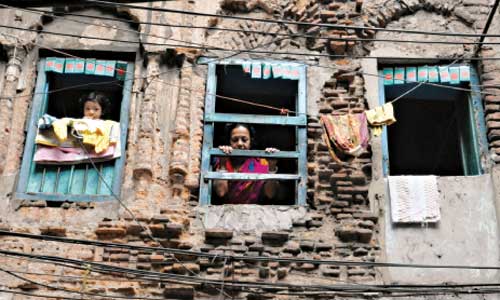NO QUAKE PREPAREDNESS : People at high risk
The people in Bangladesh stand exposed to high risks in the event of a powerful quake striking as the country completely lags behind in the preparedness for tackling the aftermaths, said experts.
They said that the lack of the preparations could in no way be justified by the nation after getting repeated wakeup calls that Bangladesh could be struck by powerful quakes.
They said that Bangladesh’s location close to three active faults placed it on the quake prone zone.
Dawki, Madhupur and Himalayan faults
They said that the Dawki fault makes the Sylhet-Mymensingh zone highly vulnerable to powerful quakes.
The Madhupur fault makes the Dhaka-Comilla zone vulnerable
In the backdrop of the 6.7 magnitude quake that struck India’s remote northeastern province of Manipur at dawn on Monday, media reports quoting relief and disaster management secretary Shah Kamal about a staggering number of 72,000 risky buildings in the capital was bone chilling.
At least seven lives were lost and over 100 other were injured while fleeing homes in panic during the longest ever jolts felt across Bangladesh, New Age reported.
The epicenter of Monday’s quake was 353 km to the northeast of Agargaon, Bangladesh’s seismic centre, according to the met office.
The powerful jolts brought people out of their homes in most of the cities and towns across Bangladesh.
Many of the newly constructed buildings in the rural areas would also prove risky in the event of a powerful quake striking.
Experts called for raising awareness of the people about the dos and don’ts when a quake hits and in its aftermath.
Dhaka University’s Institute of Disaster Management and Vulnerability Studies founding director Khondoker Mokaddem Hossain described the awareness level of the people and the country’s status of preparedness in dealing with the when a quake strikes and its aftermath as completely inadequate.
He said that in the event of a quake striking at 7.5 magnitude, 40 to 45 per cent of the buildings in the capital would collapse.
And the government lacks the capacity to remove 95 per cent of the debris, said Professor Mokaddem.
He said that the country could not until now develop any mechanism to save at
least 30,000 buildings constructed in the capital 30 years ago or earlier, with no built in safety measures to withstand powerful quakes.
Even the new buildings are building code noncompliant, he said.
Due to poor enforcement the mandatory building code is seldom followed by the real estate companies, he said.
The upshot is that a large number of people are living in risky high-rise apartments buildings constructed by the developers, he said.
New buildings constructed after piling but lacking basements would be vulnerable in the event of a quake striking, he said.
He described the number of teachers and imams trained by the government as volunteers for quake drills at schools as too inadequate to face the aftermaths.
Professor Mokaddem for increasing the number of fire tenders by at least 10 times.
He also called for increasing the number of civil defence and fire service personnel.
Though the government planned to train 62,000 volunteers, only 30,000 could be trained and provided with the needed equipment, said Disaster Management officials.
IDMVS teacher Bibhuti Bhushan Sikder called for strict and unwavering enforcement of building code to improve safety compliance.
Unless enforced no law could address the vulnerability of the citizens, he said.
Abdul Kayum, national project director of Comprehensive Disaster Management Programme, said the government had completed risk assessment, trained volunteers and provided the required equipment to different departments.
He said that the issue was incorporated in the school curriculum.
The government also held preparedness drills at schools and developed the capacity of various departments to tackle quakes.
He, however, admitted that the drills were inadequate and public awareness was low due to lack of continuity in launching awareness campaigns.
CDMP national project director said that administrative and political commitments were essential for the enforcement of the building code.
He called for the creation of a separate department with countrywide network for the enforcement of the building code ending the dependence on Rajdhani Unnayan Kotripakkha and similar bodies in other cities.
Engineers posted at district and upazila levels needed thorough training on how to enforce the building code, he said.
- See more at: http://newagebd.net/190792/no-quake-preparedness-people-at-high-risk/#sthash.Jg87FpB4.dpuf











